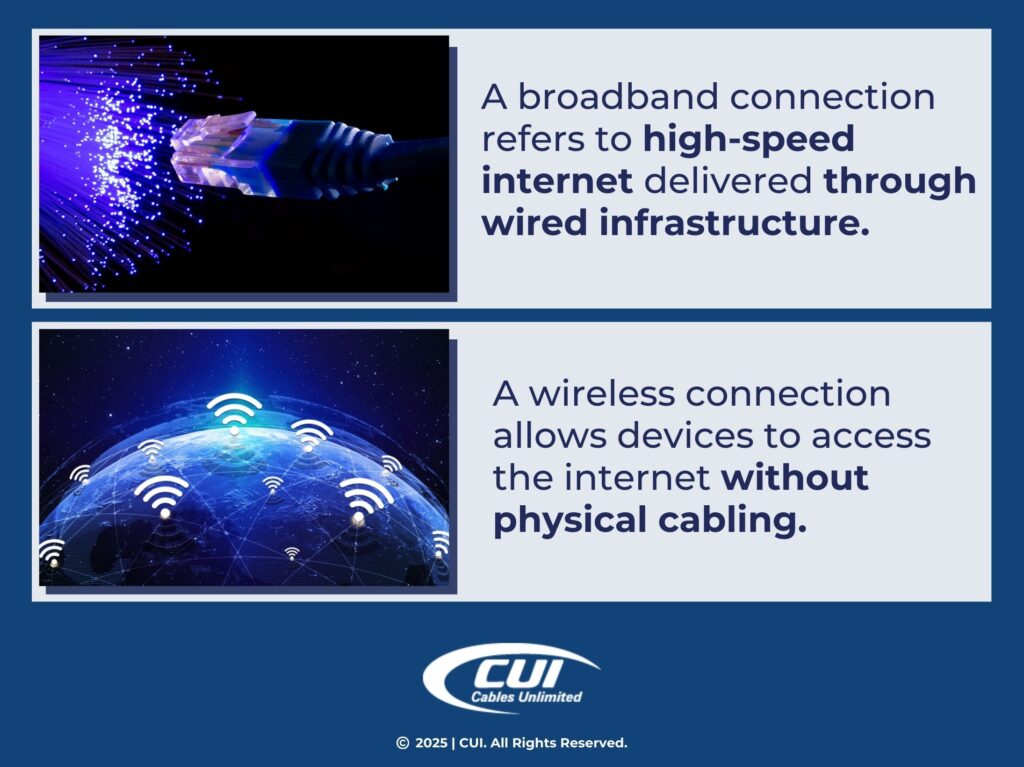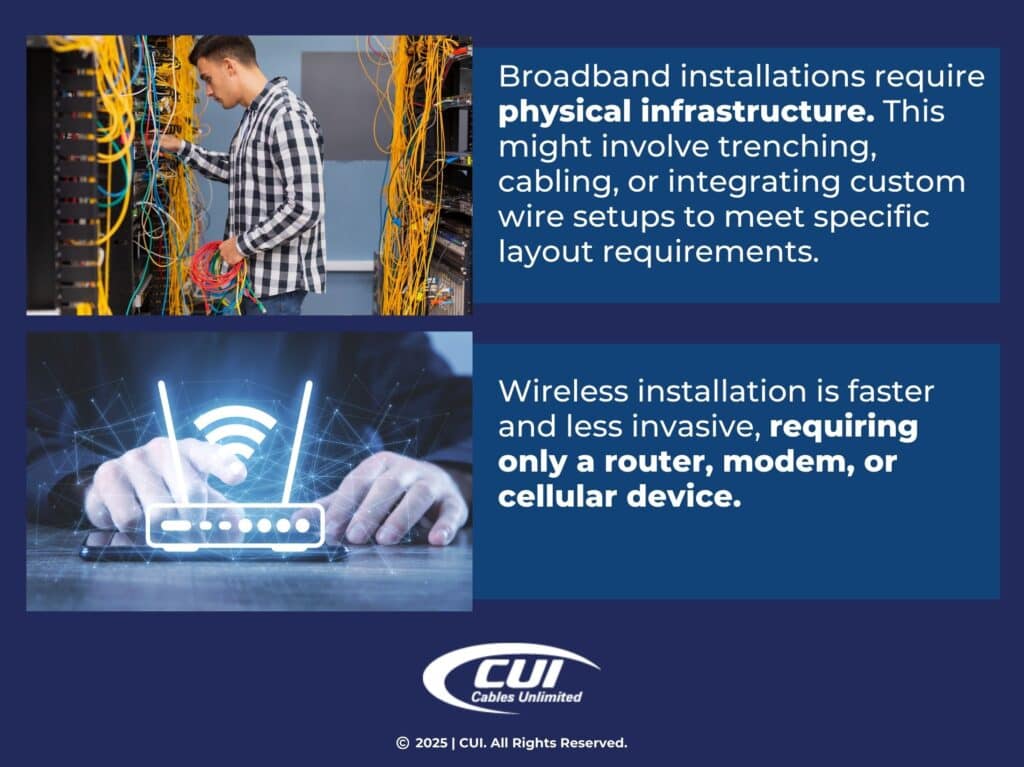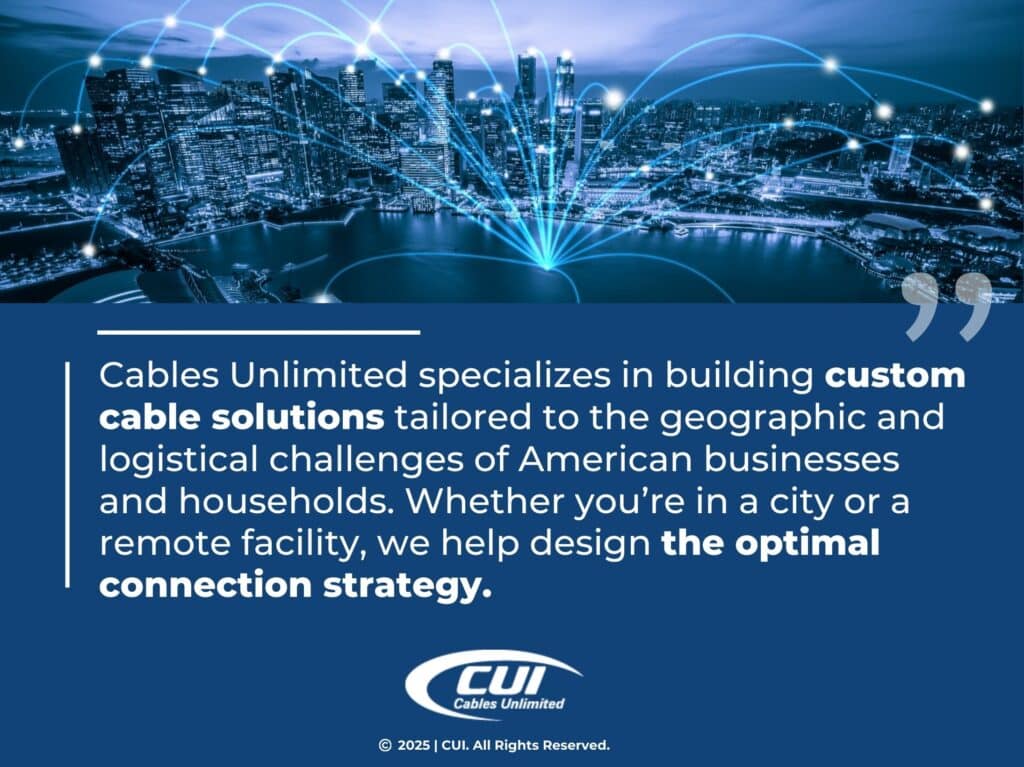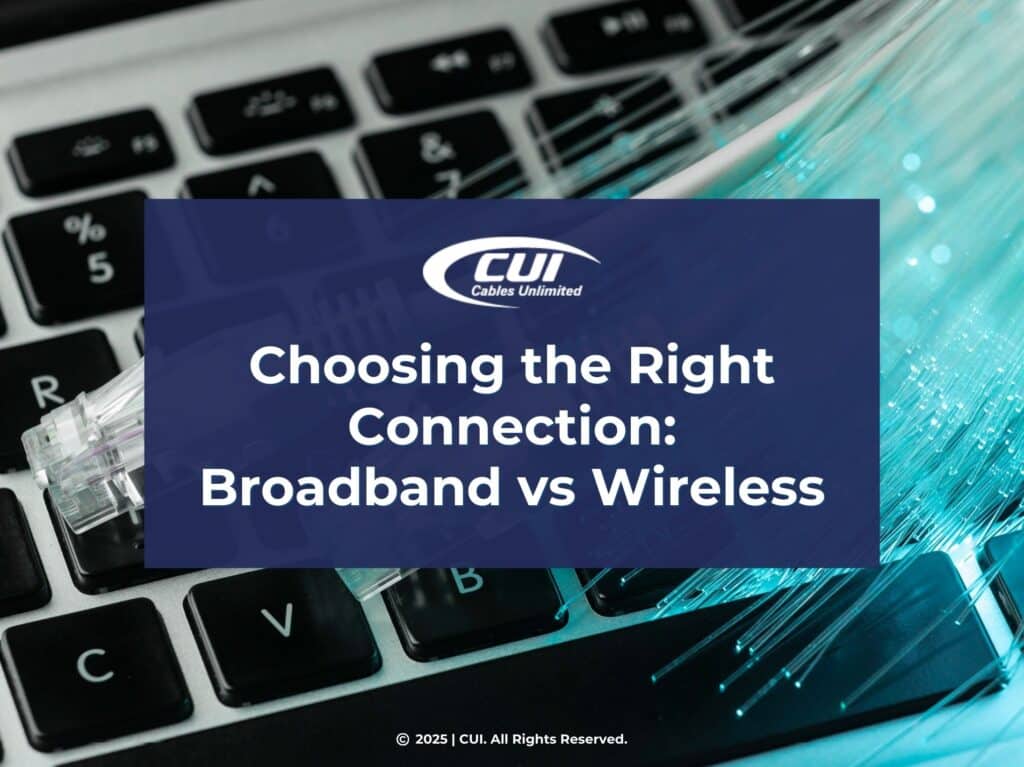When choosing how to connect to the internet, the decision often comes down to broadband or wireless. Each method has its advantages, but the key is understanding which aligns best with your unique requirements, whether you’re managing a busy household, a growing business, or a remote team. This article will help you evaluate both options, understand the key differences, and determine which solution fits best for your home or business in the USA. If you’re unsure which direction to take, call Cables Unlimited today to speak with a connectivity expert who can help you make the smartest choice.
What Is a Broadband Connection?
A broadband connection refers to high-speed internet delivered through wired infrastructure. In many regions of the USA, broadband is primarily delivered through fiber optic communication cables, which offer superior speed and reliability compared to older technologies like DSL or cable.
Broadband fiber optic cables use light signals to transmit data, allowing for faster speeds and higher bandwidth. These connections are ideal for businesses that rely on large file transfers, video conferencing, or constant uptime. A wired broadband setup ensures stability and minimizes interference, making it a go-to solution for demanding internet users.

What Is a Wireless Connection?
A wireless connection allows devices to access the internet without physical cabling. Common types include Wi-Fi, cellular data (4G/5G), and satellite internet. Wireless is valued for its flexibility, mobility, and quick deployment. It has become a viable alternative in areas where wired broadband is unavailable or cost-prohibitive. However, wireless connections depend heavily on signal strength, network congestion, and environmental factors. Users may experience speed fluctuations or latency, particularly in crowded or remote locations.
Speed and Bandwidth: Which Performs Better?
Speed and bandwidth are critical when selecting an internet connection. Broadband fiber optic systems provide high bandwidth cable performance, capable of supporting simultaneous users and data-heavy applications without interruption. Wireless, while convenient, often has lower bandwidth limits and is more prone to performance drops during peak usage times.
If your operations involve video streaming, cloud computing, or remote work, a broadband connection is typically the better choice, especially via fiber optic communication systems.
Installation and Infrastructure Needs
Broadband installations require physical infrastructure. This might involve trenching, cabling, or integrating custom wire setups to meet specific layout requirements. Though the upfront investment can be higher, the long-term performance often justifies the cost.
Wireless installation is faster and less invasive, requiring only a router, modem, or cellular device. For temporary setups or mobile units, wireless is the clear winner. That said, some hybrid systems use both broadband and wireless, connected by custom cable solutions, to achieve flexibility without sacrificing speed.
Reliability and Performance Over Time
Fiber optic broadband connections are known for their consistency. Since they are less affected by environmental interference, they offer a more stable experience, especially in adverse weather or high-density locations.
Wireless systems can be impacted by obstacles such as walls, signal congestion, or distance from the access point. While modern technology has improved wireless reliability, it still doesn’t match the dependable performance of high-quality broadband cable installations.

Security and Data Protection
A broadband connection delivered through fiber optic cables provides a naturally secure network. Physical cabling reduces the risk of external interception. Businesses handling sensitive data often opt for custom cable connections to control their network architecture and limit vulnerabilities.
Wireless networks are more exposed to potential breaches. Encryption and secure access protocols are essential to minimize risks However, there’s still an inherent exposure compared to a closed, wired system.
Basic cybersecurity principles, such as those outlined by the National Institute of Standards and Technology, play a crucial role in protecting network integrity regardless of connection type.
Cost and Scalability
Initial costs for broadband connections, especially fiber optic communication cables, can be higher due to equipment and installation. However, these setups typically offer lower maintenance costs and better long-term value. They can also be easily scaled by expanding custom wire configurations as needs grow.
Wireless plans may have lower startup costs, but data caps, service limitations, and additional equipment can increase total expenses over time. Scalability is possible but often comes with trade-offs in performance or reliability.
Location and Environmental Considerations in the USA
Urban areas in the USA often have access to high-speed fiber broadband, making wired connections more accessible and affordable. In contrast, rural or remote areas may lack the infrastructure, making wireless or satellite options more practical.
Cables Unlimited specializes in building custom cable solutions tailored to the geographic and logistical challenges of American businesses and households. Whether you’re in a city or a remote facility, we help design the optimal connection strategy.
When Broadband Connection Is the Better Choice
Broadband is ideal for users who need:
- High-speed and high-bandwidth performance
- Consistent uptime for business operations
- Secure networks with limited interference
- Scalable infrastructure for growing demands
When Wireless Connection Makes More Sense
Wireless is better suited for:
- Mobile or remote locations
- Temporary setups or rental properties
- Users with light or moderate internet usage
- Areas where broadband infrastructure isn’t feasible

Why Custom Cable Solutions Offer the Best of Both Worlds
Sometimes, the best setup involves both technologies. A hybrid approach—where wireless systems are supported by robust broadband infrastructure via custom cable connection—can deliver both flexibility and stability. This is especially beneficial for large buildings, outdoor facilities, or enterprises with specialized networking needs.
Custom cabling enables unique configurations, allowing businesses to optimize traffic flow, maintain security, and adapt as technology evolves. To learn how this can work for your specific environment, call Cables Unlimited today and speak directly with one of our connectivity experts.
Final Thoughts: Making a Smart, Long-Term Connectivity Decision
Choosing between broadband and wireless doesn’t have to be complicated. Start by evaluating your performance needs, security expectations, budget, and location. Broadband fiber optic cable systems offer unmatched reliability and speed, while wireless delivers agility and ease of use.
At Cables Unlimited, we help clients across the USA make informed connectivity decisions. Our team can design, install, and maintain custom wire and cable solutions that bridge the gap between wired and wireless needs.
Need help finding the right connection? Contact Cables Unlimited today to build a network that meets your exact requirements.




